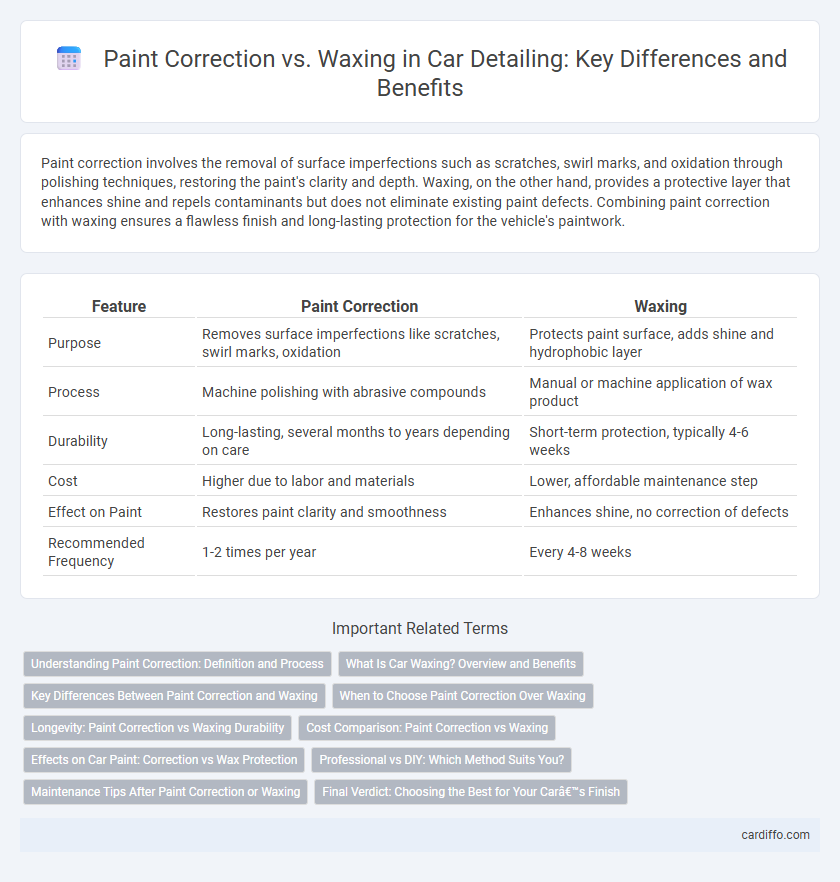Paint correction involves the removal of surface imperfections such as scratches, swirl marks, and oxidation through polishing techniques, restoring the paint's clarity and depth. Waxing, on the other hand, provides a protective layer that enhances shine and repels contaminants but does not eliminate existing paint defects. Combining paint correction with waxing ensures a flawless finish and long-lasting protection for the vehicle's paintwork.
Table of Comparison
| Feature | Paint Correction | Waxing |
|---|---|---|
| Purpose | Removes surface imperfections like scratches, swirl marks, oxidation | Protects paint surface, adds shine and hydrophobic layer |
| Process | Machine polishing with abrasive compounds | Manual or machine application of wax product |
| Durability | Long-lasting, several months to years depending on care | Short-term protection, typically 4-6 weeks |
| Cost | Higher due to labor and materials | Lower, affordable maintenance step |
| Effect on Paint | Restores paint clarity and smoothness | Enhances shine, no correction of defects |
| Recommended Frequency | 1-2 times per year | Every 4-8 weeks |
Understanding Paint Correction: Definition and Process
Paint correction is a meticulous process that involves the removal of surface imperfections such as swirl marks, scratches, and oxidation to restore a vehicle's paint to a smooth, glossy finish. This technique utilizes abrasive compounds and polishing machines to level the clear coat, enhancing depth and clarity without adding any protective layer. Unlike waxing, which merely applies a protective sealant, paint correction fundamentally improves the paint's condition by addressing damage at a microscopic level.
What Is Car Waxing? Overview and Benefits
Car waxing involves applying a protective layer of natural or synthetic wax to the vehicle's exterior, enhancing its shine and providing a barrier against environmental contaminants. This process helps maintain the paint's appearance by repelling dirt, water, and UV rays, which can cause fading and oxidation. Regular waxing extends the lifespan of the paint job, improves gloss, and makes future cleaning easier by preventing buildup.
Key Differences Between Paint Correction and Waxing
Paint correction targets surface imperfections such as scratches, swirl marks, and oxidation by using abrasive polishing compounds to restore the clear coat's smoothness and clarity. Waxing applies a protective layer made from natural or synthetic waxes to enhance gloss and provide a barrier against contaminants, but it does not remove imperfections. The key difference lies in functionality: paint correction is a restorative process that improves the paint's condition, while waxing is a maintenance step focused on protection and shine.
When to Choose Paint Correction Over Waxing
Choose paint correction over waxing when your vehicle's paint has visible imperfections such as swirl marks, scratches, or oxidation that require more intensive restoration. Paint correction involves polishing techniques that remove a thin layer of clear coat to restore smoothness and depth, unlike waxing which only provides a protective layer. Opt for paint correction to rejuvenate the paint surface before applying a wax or sealant for long-lasting shine and protection.
Longevity: Paint Correction vs Waxing Durability
Paint correction delivers longer-lasting results by removing surface imperfections and restoring the clear coat, which can maintain a flawless finish for months to years depending on environmental exposure. Waxing provides a protective barrier that enhances shine and repels contaminants but typically lasts only 2 to 6 weeks due to its softer composition and environmental factors. Choosing paint correction over waxing significantly improves durability by addressing the paint's condition rather than just applying a temporary protective layer.
Cost Comparison: Paint Correction vs Waxing
Paint correction is generally more expensive than waxing due to its intensive labor and specialized equipment, with costs ranging from $300 to $1,000 depending on vehicle size and paint condition. Waxing typically costs between $50 and $150 and offers temporary protection by sealing the surface, while paint correction involves removing imperfections for a longer-lasting, flawless finish. Investing in paint correction provides a durable solution that reduces the frequency of waxing, potentially lowering long-term detailing expenses.
Effects on Car Paint: Correction vs Wax Protection
Paint correction removes surface imperfections like swirl marks, scratches, and oxidation, restoring the car paint's clarity and depth by leveling the clear coat. Waxing provides a protective layer that enhances gloss while shielding the paint from UV rays, contaminants, and moisture, but does not fix existing paint flaws. Combining paint correction with waxing ensures both a flawless finish and durable protection that maintains the car's appearance longer.
Professional vs DIY: Which Method Suits You?
Professional paint correction uses advanced techniques like machine polishing and multi-stage compounds to remove deep scratches and oxidation, delivering a flawless finish that DIY waxing cannot match. DIY waxing provides a protective layer and enhances shine but lacks the restorative power of professional correction, making it suitable for maintenance rather than repair. Choosing between professional paint correction and DIY waxing depends on the vehicle's condition, desired results, budget, and time investment.
Maintenance Tips After Paint Correction or Waxing
Maintaining a flawless finish after paint correction or waxing requires regular washing using pH-balanced, non-abrasive car shampoos to prevent surface contaminants from dulling the paint. Employing microfiber towels for drying and applying paint sealants or ceramic coatings enhances durability and protects against environmental damage. Scheduled evaluations and light polishing help preserve gloss and remove minor imperfections, extending the life of the correction or wax layer.
Final Verdict: Choosing the Best for Your Car’s Finish
Paint correction restores the car's surface by eliminating imperfections such as swirl marks, scratches, and oxidation, making it ideal for damaged or aged finishes. Waxing provides a protective layer that enhances gloss and shields the paint from environmental contaminants, perfect for maintaining a well-corrected surface. For optimal results, choose paint correction to rejuvenate the finish, followed by waxing to preserve and protect the newly restored shine.
Paint Correction vs Waxing Infographic

 cardiffo.com
cardiffo.com